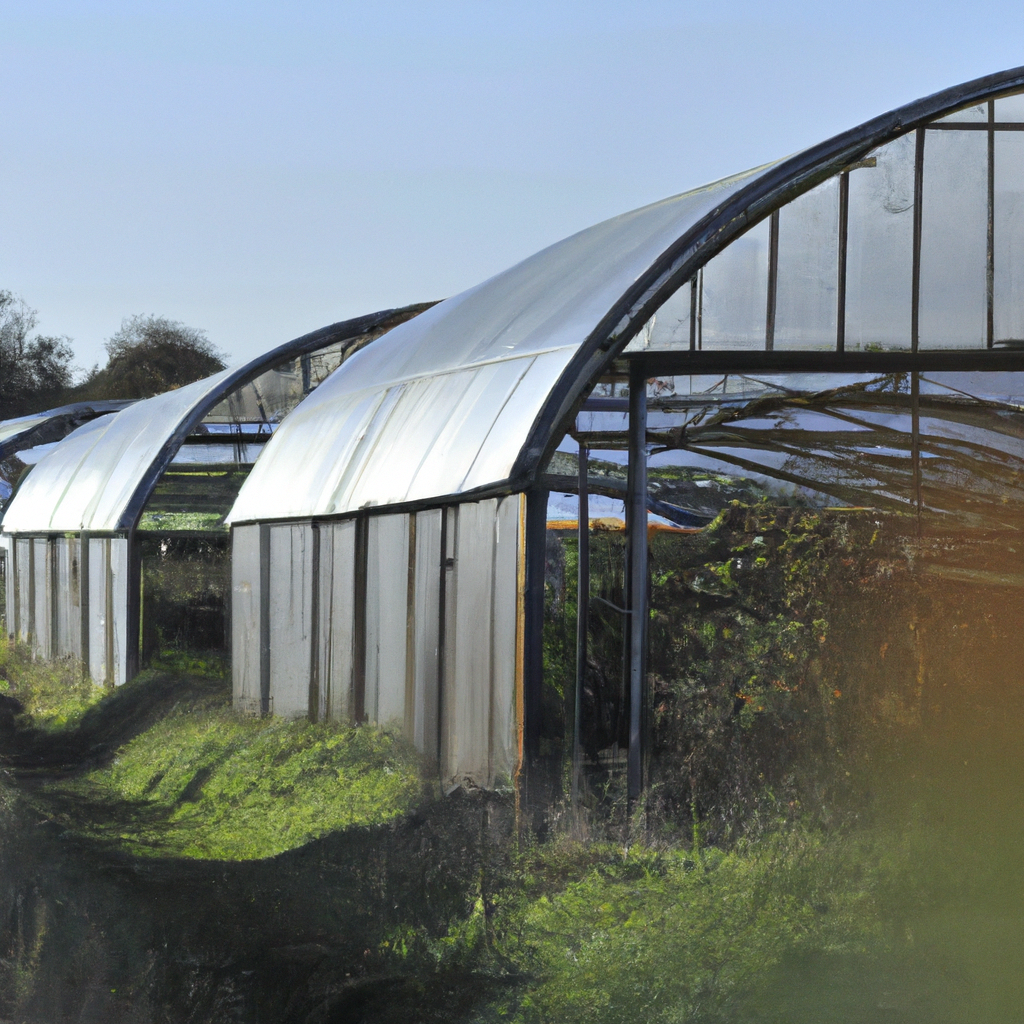
Have you ever wondered what materials are used to construct those intriguing structures known as greenhouses? Greenhouses, often hailed as havens for garden enthusiasts or agricultural connoisseurs, are made of transparent materials that allow sunlight to enter while preventing heat from escaping. These materials, commonly known as glazing, come in various forms such as glass, polycarbonate, and plastic films. Each material has its unique advantages and drawbacks, influencing factors such as insulation, cost, and durability. By understanding what greenhouses are made of, you’ll gain insight into the fascinating world of greenhouse gardening and the essential role these materials play in nurturing a flourishing environment for plants.
Glass
Glass is a popular material for constructing greenhouses due to its transparency and ability to allow sunlight to enter the structure. There are two main types of glass commonly used in greenhouse construction: float glass and tempered glass.
Float Glass
Float glass is a type of glass that is made by floating molten glass on a bed of molten metal, typically tin. This process creates a uniform glass with a smooth surface, making it ideal for greenhouse applications. Float glass is known for its clarity and ability to allow maximum sunlight to penetrate the greenhouse, promoting optimal plant growth. Additionally, float glass is relatively affordable and widely available, making it a practical choice for greenhouse owners.
Tempered Glass
Tempered glass, on the other hand, is a type of glass that has been treated with intense heat and rapid cooling to increase its strength and durability. This type of glass is highly resistant to shattering, making it a safer option for greenhouse owners, especially in areas prone to strong winds or hail. Tempered glass also has excellent thermal insulation properties, helping to maintain a stable temperature within the greenhouse and reduce energy consumption.
Polycarbonate
Another commonly used material in greenhouse construction is polycarbonate. Polycarbonate panels are lightweight and highly impact-resistant, making them suitable for regions with extreme weather conditions. These panels also offer excellent light transmission, allowing plants to receive a sufficient amount of sunlight. Polycarbonate is available in different thicknesses, providing options for varying levels of insulation and heat retention. It is also known for its UV resistance, preventing yellowing and degradation over time. Additionally, polycarbonate panels are relatively easy to install and maintain, making them a popular choice for greenhouse owners.

Plastic
Plastic materials are often used in greenhouse construction due to their versatility and cost-effectiveness. There are several types of plastic that are commonly used, including polyethylene, polyvinyl chloride (PVC), and polypropylene.
Polyethylene
Polyethylene is a lightweight and flexible plastic commonly used in greenhouse coverings. It is affordable and easy to install, making it a popular choice for hobbyist greenhouses. However, polyethylene is not as durable as other materials and may need to be replaced periodically to maintain its effectiveness.
Polyvinyl Chloride (PVC)
PVC is a versatile plastic material that is known for its durability and low maintenance requirements. It can be easily shaped and molded, making it suitable for creating custom greenhouse structures. PVC also has excellent weather resistance, making it a long-lasting option for greenhouse construction. However, the production and disposal of PVC can have negative environmental impacts, so it is important to consider sustainability factors when choosing this material.
Polypropylene
Polypropylene is a thermoplastic material that offers excellent resistance to chemicals and high temperatures. It is lightweight, strong, and durable, making it a suitable choice for greenhouse applications. Polypropylene panels are often used for glazing or creating partitions within the greenhouse. This material is also recyclable, making it a more sustainable option compared to other plastics.
Wood
Wood is a traditional and aesthetically pleasing choice for greenhouse construction. It offers natural insulation properties and can create a cozy and inviting atmosphere for plants. Some commonly used wood materials for greenhouses include cedar, redwood, and treated lumber.
Cedar
Cedar is a popular wood choice for greenhouse construction due to its natural resistance to decay and insect damage. It is a durable and long-lasting option that provides excellent insulation. Cedar also has a distinctive aroma that acts as a natural insect repellent, further protecting the plants within the greenhouse. Additionally, cedar is a sustainable choice as it is often harvested from responsibly managed forests.
Redwood
Redwood is another type of wood that is commonly used in greenhouse construction. Similar to cedar, redwood has natural resistance to decay and insect infestation. It offers excellent insulation properties and can provide a stable and favorable environment for plant growth. However, redwood may be more expensive compared to other wood options.
Treated Lumber
Treated lumber is a type of wood that has been chemically treated to enhance its resistance to rot, insects, and decay. It is a cost-effective option for greenhouse construction and provides decent insulation properties. However, it is important to choose treated lumber that is safe for plant health and free from harmful chemicals. It is recommended to use treated lumber that is specifically designed for outdoor or greenhouse use.

Metal
Metal materials are valued for their strength and durability, making them suitable for greenhouse construction. Two commonly used metals in greenhouse construction are aluminum and galvanized steel.
Aluminum
Aluminum is a lightweight and corrosion-resistant metal that is widely used in greenhouse frames and structures. It is durable, low maintenance, and does not rust, making it a popular choice for greenhouse owners. Aluminum frames are also easy to assemble and disassemble, allowing for greater flexibility in greenhouse design and layout. Additionally, aluminum is a recyclable material, making it an environmentally friendly choice.
Galvanized Steel
Galvanized steel is a type of steel that has been coated with a layer of zinc to protect it from corrosion. This protective coating makes galvanized steel highly resistant to rust and ensures its longevity in greenhouse construction. Galvanized steel frames offer exceptional strength and stability, making them suitable for larger greenhouse structures or regions with harsh weather conditions. However, galvanized steel can be heavier and more costly compared to other materials.
Foundation Materials
The choice of foundation materials for a greenhouse greatly affects its stability and longevity. Two commonly used foundation materials are concrete and gravel.
Concrete
Concrete is a popular choice for greenhouse foundations due to its strength, stability, and longevity. A concrete foundation provides a solid base for the greenhouse structure and helps to keep it anchored in place. It is a durable material and can withstand heavy loads, making it suitable for larger greenhouses. Concrete also offers good insulation properties, helping to maintain a stable temperature within the greenhouse. However, constructing a concrete foundation may require professional assistance and can be more expensive compared to other options.
Gravel
Gravel is a more affordable alternative for greenhouse foundations. It is relatively easy to install and can provide good drainage for the greenhouse. Gravel also offers adequate stability for smaller greenhouse structures, though it may not be as suitable for larger or more permanent setups. It is important to ensure proper compaction of the gravel base to prevent sinking or shifting of the greenhouse over time.

Insulation
Insulation plays a crucial role in maintaining a stable and favorable environment within the greenhouse. Three commonly used insulation materials in greenhouse construction are polyurethane foam, fiberglass, and bubble wrap.
Polyurethane Foam
Polyurethane foam is a highly effective insulation material that provides excellent thermal resistance. It can be applied to the walls, roof, and floor of the greenhouse to minimize heat loss during colder months and reduce heat gain in warmer months. Polyurethane foam insulation also helps to regulate temperature fluctuations and reduce energy consumption. However, professional installation is usually required for applying polyurethane foam insulation.
Fiberglass
Fiberglass insulation is a cost-effective option for greenhouse insulation. It is widely available and relatively easy to install. Fiberglass blankets or batts can be placed between the framing members or applied to the greenhouse walls and roof to reduce heat loss. It is important to ensure proper sealing and covering of fiberglass insulation to prevent moisture damage and ensure its effectiveness.
Bubble Wrap
Bubble wrap is a simple and affordable option for greenhouse insulation. It can be applied to the greenhouse walls and roof to create an additional layer of insulation. Bubble wrap acts as a barrier to reduce heat loss and provide some protection against temperature fluctuations. However, bubble wrap insulation may not be as durable or effective as other materials and may need to be replaced more frequently.
Structural Supports
Structural supports are essential for ensuring the stability and integrity of the greenhouse structure. Two commonly used structural supports in greenhouse construction are steel framework and aluminum framework.
Steel Framework
Steel framework provides exceptional strength and durability for greenhouse structures. It can withstand heavy loads and is suitable for larger or commercial greenhouses. Steel frames offer stability in regions with high winds or snow loads, ensuring the longevity of the greenhouse. However, steel may be more expensive and heavier compared to other materials, requiring professional assistance for installation.
Aluminum Framework
Aluminum framework is a lightweight and corrosion-resistant option for greenhouse construction. It offers good stability and durability while being relatively easy to assemble and disassemble. Aluminum frames are commonly used for smaller or hobbyist greenhouses. They can provide adequate support and allow for flexibility in greenhouse design and layout. Additionally, aluminum is a recyclable material, making it an environmentally friendly choice.

Sealing Materials
Proper sealing is essential to prevent air and moisture leaks in the greenhouse structure. Two commonly used sealing materials in greenhouse construction are rubber gaskets and silicone caulk.
Rubber Gaskets
Rubber gaskets are commonly used to seal joints and connections in greenhouse structures. They provide a tight and flexible seal, preventing air and moisture infiltration. Rubber gaskets are known for their durability and resistance to extreme temperatures. They are relatively easy to install and can be replaced if needed.
Silicone Caulk
Silicone caulk is a versatile sealing material that can be used for various greenhouse applications. It provides a durable and waterproof seal, making it suitable for sealing gaps, joints, and seams in the greenhouse structure. Silicone caulk is resistant to temperature fluctuations and can withstand exposure to sunlight and moisture. It is important to choose a high-quality silicone caulk that is specifically designed for outdoor or greenhouse use.
Ventilation Systems
Proper ventilation is crucial for maintaining optimal growing conditions within the greenhouse. Two commonly used ventilation systems in greenhouses are vent windows and roof vents.
Vent Windows
Vent windows are an essential component of greenhouse ventilation systems. They provide a means of passive cooling by allowing hot air to escape and fresh air to enter the greenhouse. Vent windows can be manually operated or connected to automated controls, allowing for increased convenience and efficiency. The size and placement of vent windows should be carefully considered to ensure adequate airflow and prevent temperature imbalances within the greenhouse.
Roof Vents
Roof vents are another effective way to provide natural ventilation in greenhouses. They are typically located at the highest point of the greenhouse roof to allow hot air to rise and escape. Roof vents can be manually operated or connected to automatic opening devices, enabling them to open and close based on temperature or humidity levels. The installation of roof vents should be carefully considered to ensure proper sealing and protection against water infiltration during rainfall.

Additional Features
In addition to the essential components mentioned earlier, there are several additional features that can enhance the functionality and efficiency of a greenhouse.
Heating Systems
Heating systems are essential for maintaining a suitable temperature within the greenhouse, especially during colder months or in regions with a cold climate. Common heating systems include gas or electric heaters, radiant floor heating, or even geothermal systems. The choice of heating system should be based on the size of the greenhouse, the desired temperature range, and energy efficiency considerations.
Cooling Systems
Cooling systems are important for preventing overheating and excessive humidity within the greenhouse, particularly during hot summer months or in regions with a warm climate. Various cooling methods can be used, such as natural ventilation, shade cloth, evaporative cooling, or misting systems. It is essential to choose a cooling system that is effective, energy-efficient, and suitable for the specific greenhouse requirements.
Automated Controls
Automated controls can greatly simplify greenhouse management and optimize plant growth. These controls can include temperature and humidity sensors, timers, and climate control systems. Automated controls allow for precise monitoring and adjustment of environmental conditions within the greenhouse, ensuring optimal plant health and productivity. These systems can also help save energy by automating heating, cooling, and ventilation processes.
In conclusion, greenhouses are constructed using a variety of materials and components to create a controlled environment for plant growth. From the choice of glazing materials like glass or polycarbonate to the selection of foundation materials, insulation, and ventilation systems, every aspect of greenhouse construction plays a vital role in creating a thriving and sustainable growing space. Consideration of factors such as durability, effectiveness, sustainability, and cost should guide the selection of materials and features to ensure the success of the greenhouse in its intended application.

